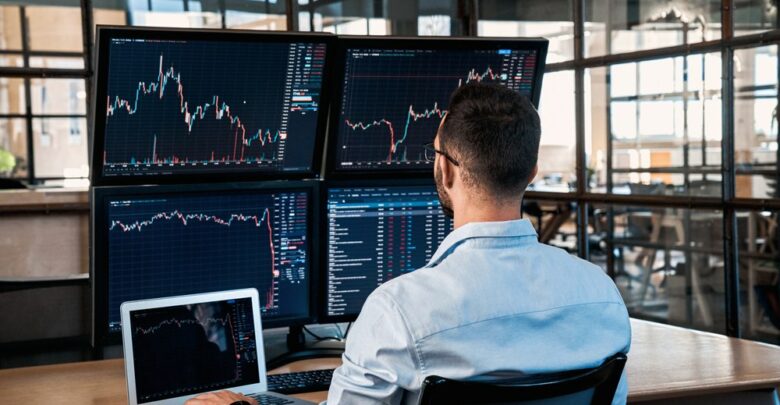Proprietary Trading (Prop Trading) occurs when a bank or company trades stocks, derivatives, bonds, commodities, or other financial instruments for its own account, using its own money rather than client funds. This allows the firm to make entire profits from a trade, as opposed to only commissions for processing trades for clients.
This form of trade is conducted by banks and other financial entities with the intention of generating excessive profits. When it comes to market intelligence, such organizations typically have an advantage over regular investors. Having powerful modelling and trading tools is another benefit.
To optimize gains, proprietary traders employ tactics such as merger arbitrage, index arbitrage, global macro-trading, and volatility arbitrage. Private traders can use high-tech tools and a lot of information to help them make important decisions.
Even while proprietary trading is usually perceived as dangerous, it is frequently one of the most profitable operations of commercial and investment banks. During the 2008 financial crisis, organizations such as prop traders and hedge funds were scrutinized for contributing to the disaster.
The Volcker rule, which severely restricts proprietary trading, was implemented to govern the operations of proprietary traders. Avoiding potential conflicts of interest between the firm and its clients was a primary concern. Prop trading isn’t good for individual investors because it doesn’t include trades done for clients.
The Advantages of prop Trade
Profits are one of the benefits of proprietary trading. Unlike when serving as a broker and earning commissions, the whole profit from prop trading is retained by the firm. As a private trader, the bank derives the greatest possible profit from the trade.
A further advantage of proprietary trading is that a company can stockpile assets for future use. If the firm purchases securities for speculative purposes, it can resell them to clients who are interested in purchasing them. The securities may also be lent to clients who desire to short sell them.
By utilizing prop trading, companies can swiftly become market leaders. A firm that specializes in particular types of securities can offer liquidity to investors in such securities. A company can purchase the securities with its own funds and then sell them to interested investors in the future. However, if a company purchases securities in large quantities and they lose value, it will be compelled to absorb the losses internally. Only if the price of their security inventory increases or if others purchase it at a higher price, will the company profit.
Preferred proprietary trading technology and other automated tools are accessible to proprietary traders. They have access to a wide variety of markets and the ability to automate operations and engage in high-frequency trading thanks to sophisticated computerized trading platforms. Traders can create trading strategies, verify their viability, and execute simulations on their computers.
In the majority of privately held corporations, the trading platforms employed are internal and accessible solely to the firm’s traders. Businesses get huge advantages from possessing trading software, which retail traders lack.
In contrast to Prop…
Hedge funds invest in client funds in the financial markets. They are compensated for producing profits from these assets. When proprietary traders invest in the financial markets with their own firm’s funds, they keep the entire profit. In contrast to proprietary traders, hedge funds are accountable to their investors. But they are also targeting of the Volcker Rule, which tries to limit how much risk financial institutions can take.
By investing in the financial markets, proprietary trading tries to boost a company’s balance sheet. Since they are not dealing with client funds, traders can take larger risks. Firms engage in proprietary trading with the idea that they possess a competitive advantage and have access to significant information that will enable them to generate substantial profits. The traders exclusively answer to their respective firms. The firm’s clients do not profit from the profits generated via prop trading.
The Volcker Rule Regarding Insider Trading
The Dodd-Frank Wall Street Reform and Consumer Protection Act includes the Volcker rule. It was proposed by Paul Volcker, the former head of the Federal Reserve. The rule tries to prevent banks from making speculative investments that do not immediately benefit depositors. After the global financial crisis, when government authorities judged that huge banks took too many speculative risks, the rule was suggested.
Volker stated that commercial banks’ engaging in high-risk investments negatively impacted the financial system as a whole. As a means of risk mitigation, commercial banks that engaged in proprietary trading boosted their usage of derivatives. Nonetheless, this frequently exacerbated danger in other regions.
The Volcker Rule forbids banks and institutions that own banks from engaging in proprietary trading or owning or investing in hedge funds or private equity funds. From a market-making perspective, banks priorities client satisfaction and are compensated through commissions. But from the point of view of proprietary trading, the consumer doesn’t matter, and all the money goes to the banks.
By separating the two responsibilities, banks will be able to stay objective when engaging in customer-beneficial operations and limit potential conflicts of interest. As a result of the Volcker rule, large banks have isolated their proprietary trading functions from their core operations or eliminated them entirely. At the moment, companies that specialize in proprietary trading offer proprietary trading as a separate service.
The financial industry is generally opposed to both the Volcker Rule and the Dodd-Frank Act. It is viewed as futile and unneeded government meddling. For instance, as mentioned previously, banks’ proprietary trading supplies investors with significant liquidity. This source of liquidity no longer exists.
